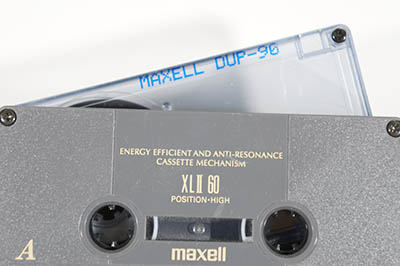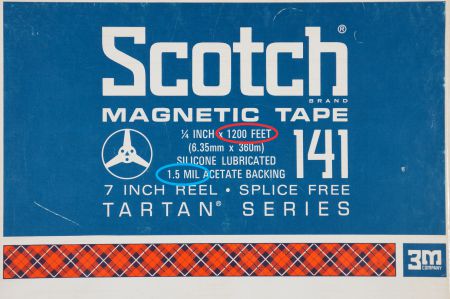How Long is My Tape?
A primer on audio tape length
By Steve Puffenberger on
Now that we’re doing lots of audio tape transfers for customers, the question I ask most frequently is “how long is the tape” (in terms of time). I realize that’s a loaded question, because without playing it it’s hard to tell how much of the tape actually has program, whether it’s recorded on one or both sides, and at what speed it runs. Then comes the variable of the type of tape. So in the “more than you wanted to know” series of blog posts, here are all the variables we look at when doing audio tape transfers, both open reel and cassette.
CASSETTE:

 Cassettes are easy, as the length is stamped on the shell somewhere, or on the label. Common lengths are C15, C30, C45, C60, C90 or C120. Because cassettes run at a standardized tape speed, 1 7/8 Inches Per Second (IPS), the label indicates the time, in minutes, the cassette could record – on both sides. So if the cassette is only recorded on one side, the running time is half of the stated time.
Cassettes are easy, as the length is stamped on the shell somewhere, or on the label. Common lengths are C15, C30, C45, C60, C90 or C120. Because cassettes run at a standardized tape speed, 1 7/8 Inches Per Second (IPS), the label indicates the time, in minutes, the cassette could record – on both sides. So if the cassette is only recorded on one side, the running time is half of the stated time.
The only difference is pre-recorded music cassettes. These tapes were cut to custom length to fit the program material. We do not recommend transferring pre-recorded music cassettes if the music can be obtained in digital form as a download or CD. The quality will be far superior.
OPEN REEL:
 Open Reel tapes are another animal altogether. Why? It’s because there are a LOT of variables, including:
Open Reel tapes are another animal altogether. Why? It’s because there are a LOT of variables, including:
- Tape speed – 1 7/8, 3¾, 7½, 15, or even 30 inches per second (IPS)
- Reel size: 3.25”, 5”, 7” or 10.5”
- Tape thickness: Tape thicknesses are 1.5mil, 1mil and .5 mil. The half-mil tape is very fragile and easy to stretch or break because it’s so thin.
- Track format: Depending on the head configuration of the recorder, some tapes have two "sides," meaning they may be played in both directions (flipped over and played without rewinding). This doubles the potential time of recording. Two-sided formats include half-track mono, and quarter-track stereo. Pro formats, half-track stereo or full-track mono, record only in one direction, and have only one "side."
If the tape is in a branded box, it probably has the specs listed (see picture), but the big variable is the speed at which the tape was recorded. Hopefully someone wrote the speed on the box. If they did you can find a the length in this chart:
Open Reel Tape Speed Comparison
| Reel Size |
Thickness |
Tape Length |
Recording Time per side at Tape Speed (Minutes)* |
| (Inches) |
(Mil) |
(Feet) |
1 7/8 ips |
3 3/4 ips |
7.5 ips |
15 ips |
| 3 ¼ |
1.5 |
250 |
27 |
13 |
7 |
3 |
| 3 ¼ |
1 |
400 |
43 |
21 |
11 |
5 |
| 3 ¼ |
0.5 |
800 |
85 |
43 |
21 |
11 |
| 5 |
1.5 |
600 |
64 |
32 |
16 |
8 |
| 5 |
1 |
900 |
96 |
48 |
24 |
12 |
| 5 |
0.5 |
1800 |
192 |
96 |
48 |
24 |
| 7 |
1.5 |
1200 |
128 |
64 |
32 |
16 |
| 7 |
1 |
1800 |
192 |
96 |
48 |
24 |
| 7 |
0.5 |
2400 |
256 |
128 |
64 |
32 |
| 10 ½ |
1.5 |
2500 |
267 |
133 |
67 |
33 |
| 10 ½ |
1 |
3600 |
384 |
192 |
96 |
48 |
| 10 ½ |
0.5 |
4800 |
512 |
256 |
128 |
64 |
*Recording time in one direction (one side). Double time if recorded on both sides. For 30ips pro tapes, half the time of 15 ips.
If no writing on the box tells you the speed, the only way we can figure it out is to play it. Once we do we'll adjust the quote.
Complications
It's hard enough trying to figure out how long a tape is in order to price a transfer job. Open reel tapes especially, and to some degree cassettes, can have hidden problems that fall into the "restoration" category. These include:
- Bad splices.
If the tape was spliced, over the years the splices can dry out, and as it plays the splice comes apart. Usually this can be repaired with no loss of program, but if the tape is damaged around the splice, a few seconds of program may be lost. One splice repair is included per open reel tape, but if more breaks are encountered, extra fees may be added.
- Cassette Breaks.
We offer restoration services when cassettes go bad. If the tape is mangled and hanging out of the cassette, that's an easy splice fix to remove the damaged tape at no extra charge (some program will be lost). If the tape has retracted into the cassette, either from a break or just coming off the reel, we have to dissassemble the cassette. If it is a screw-type cassette, it can be opened and repaired. If it is a welded cassette (without screws) we have to break the cassette shell and move the tape to a new shell. Both are restoration options at extra cost.
- Brittle or stretched tape.
Some older acetate tapes may break under tension from our tape machines, or sometimes just by flexing the tape. We can splice those breaks and use special low tension techniques if necessary. Polyester tapes won't break under tension but they stretch. If a section of tape is found to be stretched it will have to be spliced out.
- Dry oxide.
Some very old tapes dry out over time and the oxide that holds the recording actually flakes off during playback. There is little that can be done with those. You will hear dropouts where the program material has been lost.
- Sticky Shed.
This affects "high output" tapes from the late 70s to the early 90s. The glue holding the oxide absorbs water and become sticky. This either gunks up the heads so the audio quality degrades, or it can actually jam up the mechanism and prevent the tape from playing. At worst, sticky shed can peel away the oxide as the tape unspools, destorying the tape. They can be restored by baking. See our article on Tape Baking. Sticky shed can be found with open reel, cassette, and even videocassettes (especially tapes made by Ampex).
- Tape Hiss, Background Noise or Other Issues.
Amateur recordings sometimes have issues from the get-go caused by mistakes the operator made, or problems with the recorder. These include low recording levels, which when amplified have very bad hiss, background sounds that are louder than the voices you want to hear, overdriven recording levels that are distorted, improper head alignment or speed variations. Our restoration tools can correct many issues, but not all. We will inform you of problems we encounter and estimate cost to restore if restoration is possible.
- Multi-track tapes
Does anyone remember Quadrophonic? In the late 60s and early 70s, 4-channel tapes were a thing, with separate tracks for two additional speakers behind the listener - the original "surround sound." Then for semi-pro use they brought out 4-channel multitrack recorders so that garage studios could do multiltrack recordings onto quarter-inch tape. We can play back 4 channel tapes and mix down 4-channel multitrack recordings. (We do not have capability of mixing down half-inch multilchannel tapes.)
How to Order
When it comes to quoting your tape transfer job, we’ll estimate based on the label on the box, and if there's no label we'll just make a guess, but the final bill will reflect actual time on tape, which may be more or less than the estimate.
If you have tapes to send and are unsure, send us a picture and we can probably guess from there what you have. We at Advent Media look forward to making your precious recordings listenable again!
Request your Audio Transfer Quote Learn more about Digital Transfers